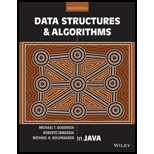
Explanation of Solution
Method equals() in CircularlyLinkedList class:
//Define the equals() method
public boolean equals(CircularlyLinkedList<E> other)
{
//Declare and initailze the Boolean variable
boolean result = false;
/*Call size() to find the first list size and assign it into "size1" variable. */
int size1 = size();
/*Call size() to find the second list size and assign it into "size2" variable. */
int size2 = other.size();
//Check whether the size of the two lists is equal
if(size1 != size2)
//Return false that is, two lists are not equal
return result;
/*Call equals() method recursively to check first element in two lists are equal and the result into "result" variable. */
result = head.equals(other.head);
//Check whether "result" is not equal to false
if (!result)
//Return true that is, two lists are equal
return result;
/*Assign the next of head from current list into "next" node. */
Node<E> next = head.getNext();
/*Assign the next of head from other list into "nextOfOther" node. */
Node<E> nextOfOther = other.head.getNext();
/*Loop executes until the size of current list is greater than 1. */
while (size1 > 1)
{
/*Call equals() method recursively to check all the elements in two lists are equal and assign the true if it is equal otherwise, false. */
result = next.equals(nextOfOther);
//Check whether "result" is not equal to true
if (!result)
// Break it, because, they aren't equal
break;
/*Assign the next of next from current list into "next" node...
Want to see the full answer?
Check out a sample textbook solution
Chapter 3 Solutions
Data Structures and Algorithms in Java
 EBK JAVA PROGRAMMINGComputer ScienceISBN:9781337671385Author:FARRELLPublisher:CENGAGE LEARNING - CONSIGNMENT
EBK JAVA PROGRAMMINGComputer ScienceISBN:9781337671385Author:FARRELLPublisher:CENGAGE LEARNING - CONSIGNMENT C++ Programming: From Problem Analysis to Program...Computer ScienceISBN:9781337102087Author:D. S. MalikPublisher:Cengage Learning
C++ Programming: From Problem Analysis to Program...Computer ScienceISBN:9781337102087Author:D. S. MalikPublisher:Cengage Learning New Perspectives on HTML5, CSS3, and JavaScriptComputer ScienceISBN:9781305503922Author:Patrick M. CareyPublisher:Cengage Learning
New Perspectives on HTML5, CSS3, and JavaScriptComputer ScienceISBN:9781305503922Author:Patrick M. CareyPublisher:Cengage Learning- COMPREHENSIVE MICROSOFT OFFICE 365 EXCEComputer ScienceISBN:9780357392676Author:FREUND, StevenPublisher:CENGAGE L
 Microsoft Visual C#Computer ScienceISBN:9781337102100Author:Joyce, Farrell.Publisher:Cengage Learning,
Microsoft Visual C#Computer ScienceISBN:9781337102100Author:Joyce, Farrell.Publisher:Cengage Learning, Systems ArchitectureComputer ScienceISBN:9781305080195Author:Stephen D. BurdPublisher:Cengage Learning
Systems ArchitectureComputer ScienceISBN:9781305080195Author:Stephen D. BurdPublisher:Cengage Learning





